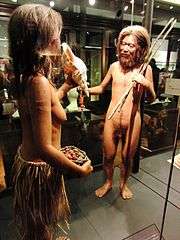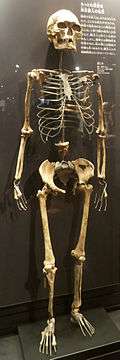Minatogawa Man
The Minatogawa people are a prehistoric people of Okinawa, Japan, represented by four skeletons, two male and two female, and some isolated bones dated between 20,000 and 22,000 years BCE. They are among the oldest skeletons of hominids yet discovered in Japan.[3][4][5][6][7]

History of the finds
The skeletons were found at the Minatogawa limestone quarry, located 10 km south of Naha, near the southern tip of the island. Okinawan businessman and amateur archaeologist Seiho Oyama noticed fossil bone fragments in some building stone blocks he had purchased from the quarry, and for two years he kept watch as the quarry was worked. In 1968 Oyama reported the finding of a human bone at the quarry to Hisashi Suzuki, a professor at Tokyo University.
A team led by Suzuki excavated the site during three seasons (1968, 1970 and 1974). Their finds were described in 1982.[5] The skeletons are now in the Anthropology Museum, Tokyo University.[8]
Description

All skeletons were found buried inside a vertical fissure in the limestone rock, about 1 meter wide, which had been filled over millennia by residual red clay mixed with travertine, limestone fragments and bones. Suzuki's excavation was limited to the part of the fissure that was exposed on the quarry's face, 5 m high and 20 m above the present sea level, and extended about 6 m into the cliff behind.[5]
The bones recovered from that fissure belonged to between 5 and 9 distinct individuals (two males and the rest females), mixed with over 200 fragments of deer and boar bones. The finds lay on a diagonal band extending down and forward by about 6 meters within the fissure. The lowest-placed skeleton (Minatogawa I, a male about 25 years old) was standing upside-down, but his bones were mostly in their anatomical positions. The other skeletons were found with their bones all mixed up and scattered over several meters. Skeleton IV, in particular, was found as two sets of bones separated by a couple of meters; his skull has a perforation that seems to have been caused by a sharp hard point, and his left and right arms seem to have been fractured the same way. Suzuki conjectures that the individuals were killed with spears or arrows by enemies who cannibalized their victims (breaking bones in the process) and then threw the remains into the fissure, which had been used as a trash dump (which explains the animal bones).[5]
The individuals were rather short (about 1.55 m for the males, 1.40 m for the females) and their cranial capacity was close to the lower end of the range of the latter prehistoric Jōmon (16,000 to 2,000 years ago) and modern Japanese.[5] The teeth were extremely worn out, suggesting an abrasive diet.[7] In one of the mandibles, the two median incisors had been knocked out at the same time, well before death—a custom that is known to have been practiced by the Jōmon people.[5]
Geologists have estimated that the fissure was created by an uplifting that bent and fractured the limestone rock layers, more than 100,000 years ago. Charcoal fragments in the fissure have been carbon-14-dated to about 16,000 and 18,000 years ago.[5]
According to Baba & Narasaki (1991), the Minatogawa man had already Mongoloid phenotypes and differed from samples of the Jomon period.[9]
In a craniometric study by Kaifu et al. (2011), Minatogawa specimens were shown to be significantly different from samples of the Jomon period and later Ryukyuan samples. The authors hypothesize that the Minatogawa people maybe originated from a population in Southeast Asia with Australo-Melanesian affinities.[10]
See also
| Wikimedia Commons has media related to Minatogawa Man. |
References
- A Couple from Minatogawa Homo sapiens - National Museum of Nature and Science
- 港川人、縄文人と似ず 顔立ち復元、独自の集団か Asahi Newspaper, 2010.6.28
- "Ancient burial remains in Okinawa cave may fill void in Japanese ancestry". The Asahi Shimbun. 9 January 2015. Archived from the original on 25 September 2015. Retrieved 4 September 2015.
- Kobayashi, H.; Hirose, T.; Sugino, M.; Watanabe, N. (1974). "TK-99. Minatogawa". Radiocarbon. 16: 384.
- Hisashi Suzuki; Kazuro Hanthara; et al. (1982). "The Minatogawa Man - The Upper Pleistocene Man from the Island of Okinawa". Bulletin of the University Museum. University of Tokyo. 19.
- Haruto Kodera (2006). "Inconsistency of the maxilla and mandible in the Minatogawa Man No. 1 hominid fossil evaluated from dental occlusion". Anatomical Science International. 81 (1): 57–61. doi:10.1111/j.1447-073X.2006.00127.x. PMID 16526598. Archived from the original on 2013-01-05.
- Yousuke Kaifu (2007). "The cranium and mandible of Minatogawa 1 belong to the same individual: a response to recent claims to the contrary". Anthropological Science. 115 (2): 159–162. doi:10.1537/ase.061208.
- Peter Brown. "Minatogawa 1". Retrieved November 21, 2016.
- Baba, Hisao; Narasaki, Shuichiro (1991). "Minatogawa Man, the Oldest Type of Modern Homo sapiens in East Asia". The Quaternary Research (Daiyonki-Kenkyu). 30 (3): 221–230. doi:10.4116/jaqua.30.221.
- Kaifu, Yousuke; Fujita, Masaki; Kono, Reiko T.; Baba, Hisao (2011). "Late Pleistocene modern human mandibles from the Minatogawa Fissure site, Okinawa, Japan: morphological affinities and implications for modern human dispersals in East Asia". Anthropological Science. 119 (2): 137–157. doi:10.1537/ase.090424.